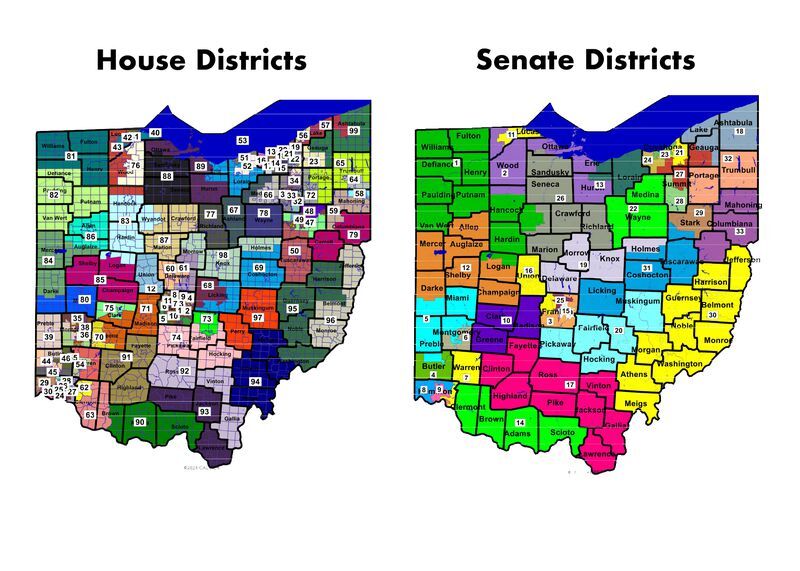Ohio Supreme Court reviewing fourth redistricting map proposal
Courtesy of the Ohio House of Representatives
Republicans propose new state legislative maps after long debate on Jan. 22, 2022.
April 8, 2022
After the Ohio Supreme Court rejected three previously proposed maps, the Ohio Redistricting Committee brought in outside personnel to assist in the configuration of a fourth map.
The Redistricting Commission announced the recruitment of two mapmakers: Douglas Johnson of the National Demographics Corporation in California and Michael McDonald, a political science professor from the University of Florida.
This comes after the Ohio Supreme Court recommended that outside mapmakers be brought in so that the original May 3 primary dates will not be pushed back. The Ohio Supreme Court requested that a fourth map be drawn up and submitted to the Ohio Secretary of State Frank LaRose’s office by March 28, so the state Supreme Court can review it by the next day.
The Ohio Supreme Court rejected the previous three on the grounds that they were “unconstitutionally gerrymandered.” Those maps previously submitted allowed multiple organizations, including the American Civil Liberties Union of Ohio, the National Redistricting Action Fund and the League of Women Voters in Ohio to file lawsuits against those maps.
Chris Glassburn, a democratic mapmaker within the Ohio Redistricting Commission assisting with the mapmaking process, talked about the difficulties of keeping primaries on time.
“There’s not a [logistical] and physical time to make that happen,” Glassburn said. “That is physically impossible to make that happen at this point.”
LaRose believes that election races within the Ohio House and Ohio Senate will not be able to make it on May 3 ballots under the current circumstances, Glassburn said.
Glassburn said early voting, including military voting for those serving currently or unable to vote at their local polling locations, should already be occurring but is currently being delayed.
A rejection of the fourth map could lead to a delay in the primary election that could potentially call for a second election at a later date so that ballots can be properly made up with the correct candidates and names, said Michael Ensley, a political science professor at Kent State.
With no map yet by the Ohio Supreme Court, Democratic members of the Ohio Redistricting Commission asked the state Supreme Court to push the date of the primaries back to June 28 or another date that would allow for enough time depending on how this fourth map will be decided on.
Not only are maps being drawn up of the districts of the Ohio House and Senate, but also a separate map is being drawn up for congressional seats in the U.S. House of Representatives. After the 2020 U.S. Census numbers were released last year, Ohio was short by over 11,000 Ohioans to keep 16 seats in the U.S. House of Representatives. Ohio will now have 15 seats until the U.S. Census numbers are revised in 2030.
Even with Ohio losing one seat in the U.S. House of Representatives, Ensley said the maps outlining Ohio’s districts for The House of Representatives “can certainly change the dynamics of the election [of the Ohio House and Senate].”
Ensley said the competitive races within the U.S. House of Representatives districts can also influence “the mobilization, how many voters [and] media coverage,” the Ohio House and Senate obtain through local elections.
Federal lawsuits, on top of state lawsuits, are also challenging the outlines of the maps and pose a threat to the primaries. Federal courts are now involved and unlike the Ohio Supreme Court, a federal court can “trump,” the state Supreme Court and move the primary date, Glassburn said.
“The premise is that because of the primary is coming up that somehow by the maps not existing it’s disenfranchising the people’s right to vote, that’s the premise of it being in federal court,” Glassburn said.
Ensley said the “most infamous,” case similar to what is occurring in Ohio is a 1993 United States Supreme Court Case, Shaw v. Reno, which Ensley said had numerous setbacks and was a “drawn out process,” that included cases of gerrymandering in the state of North Carolina. The concept of gerrymandering as Ensley said is the “driving force,” behind the setbacks of the maps already proposed and why multiple organizations have filed lawsuits against those maps.
Members of the Republican Party are asking for Ohio Supreme Court Chief Justice Maureen O’Connor to be impeached, as O’Connor has been siding with democratic justices on the Court throughout the redistricting process.
However, with some Republicans wanting O’Connor to be impeached, other Republicans like Governor Mike DeWine said an impeachment against O’Connor is “not a good idea.”
The Ohio Supreme Court can take up to three weeks to make a decision on the fourth map, as it took the state Supreme Court six months previously to decide on the first map proposal, Glassburn said.
A bipartisan process that Ensley said is a “complicated situation,” looks to find a solution with a fourth map proposal being drawn up as absentee ballots were sent out April 5.
Early voting started April 5 and will go through May 2, but some races will not appear on the ballot, such as races for state representatives, state senate and state central committee.
Anthony Zacharyasz is a reporter. Contact him at [email protected].

























